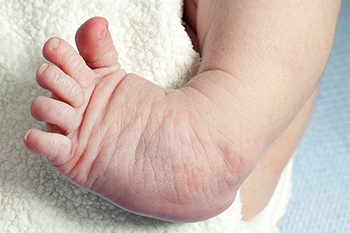
The foot condition known as clubfoot is considered to be a birth defect. It does not improve without treatment, and it is advised that a treatment program begin as early as possible. It is a foot structure deformity, and is present at birth. A noticeable sign that clubfoot is present consists of the baby’s foot turning in, forcing the bottom of the foot to face sideways. Research has indicated there are two types of clubfoot. The most common type is referred to as isolated clubfoot, and can happen when there are no other medical conditions. When other health issues and clubfoot exists, this is referred to as non-isolated clubfoot. Spina bifida can accompany clubfoot and is considered to be a birth defect of the brain, spine, and spinal cord. There may be factors that can increase the risk of having a baby born with clubfoot. These include having a baby boy, environmental factors consisting of the kinds of foods that are eaten, and genetic factors. Many pregnant women choose to have ultrasound tests performed, which can be helpful in detecting if clubfoot is present. A common treatment, which can be started after birth, is known as the Ponseti method. This consists of gently stretching the affected foot toward the correct position, followed by putting it in a cast. If your child has clubfoot, please consult with a podiatrist who can help to manage effective treatment options.
Congenital foot problems require immediate attention to avoid future complications. If you have any concerns, contact Scott Matthews, DPM, MD of Salem Foot Care . Our doctor can provide the care you need to keep you pain-free and on your feet.
Congenital foot problems are deformities affecting the feet, toes, and/or ankles that children are born with. Some of these conditions have a genetic cause while others just happen. Some specific foot ailments that children may be born with include clubfeet, polydactyly/macrodactyly, and cleft foot. There are several other foot anomalies that can occur congenitally. What all of these conditions have in common is that a child may experience difficulty walking or performing everyday activities, as well as trouble finding footwear that fits their foot deformity. Some of these conditions are more serious than others. Consulting with a podiatrist as early as possible will help in properly diagnosing a child’s foot condition while getting the necessary treatment underway.
What are Causes of Congenital Foot Problem?
A congenital foot problem is one that happens to a child at birth. These conditions can be caused by a genetic predisposition, developmental or positional abnormalities during gestation, or with no known cause.
What are Symptoms of Congenital Foot Problems?
Symptoms vary by the congenital condition. Symptoms may consist of the following:
- Clubfoot, where tendons are shortened, bones are shaped differently, and the Achilles tendon is tight, causing the foot to point in and down. It is also possible for the soles of the feet to face each other.
- Polydactyly, which usually consists of a nubbin or small lump of tissue without a bone, a toe that is partially formed but has no joints, or an extra toe.
- Vertical talus, where the talus bone forms in the wrong position causing other bones in the foot to line up improperly, the front of the foot to point up, and the bottom of the foot to stiffen, with no arch, and to curve out.
- Tarsal coalition, when there is an abnormal connection of two or more bones in the foot leading to severe, rigid flatfoot.
- Cleft foot, where there are missing toes, a V-shaped cleft, and other anatomical differences.
- Macrodactyly, when the toes are abnormally large due to overgrowth of the underlying bone or soft tissue.
Treatment and Prevention
While there is nothing one can do to prevent congenital foot problems, raising awareness and receiving neonatal screenings are important. Early detection by taking your child to a podiatrist leads to the best outcome possible.
If you have any questions please feel free to contact our office located in Wikesboro, NC . We offer the newest diagnostic tools and technology to treat your foot and ankle needs.
